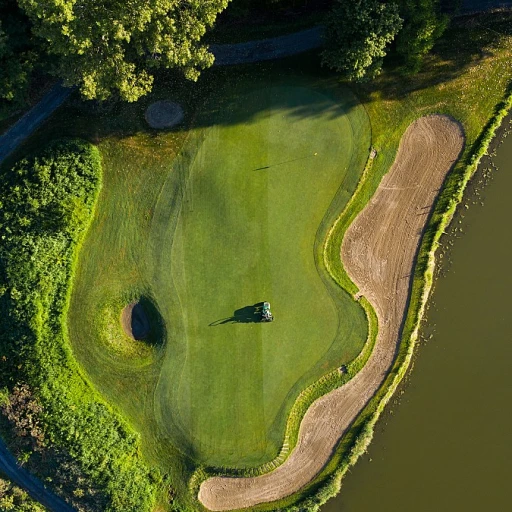
Evaluating Land and Location
Assessing the Perfect Location for a Golf Course
In the world of luxury golf courses, the location is as crucial as the design and amenities provided. Evaluating the land and its surroundings determines not only the initial investment but also the long-term success of a golf project. Choosing the right land involves considering various elements like natural landscape, soil quality, and accessibility. When considering a location for a luxury golf course, one must look for an area that offers a beautiful natural environment. The topography should present varied elevations and contours, which make the game more intriguing for players while providing stunning views. A carefully selected land will allow the course architect to create a challenging and visually appealing course design at a cost that aligns with your vision. Accessibility is another vital aspect. A location that is easily reachable yet offers a sense of exclusivity can elevate the allure of a luxury golf club. Proximity to a major city or transport routes can ensure higher membership numbers, impacting the overall revenue positively. Moreover, real estate development potential surrounding the course can play a significant role. Incorporating residential properties or partnering with luxury resorts could further enhance the project's attractiveness, offering additional streams of revenue beyond just the course fees. Joining forces with a reputable course architect and real estate experts will ensure the site chosen optimizes both the golfing experience and the economic viability. These considerations, married with strategic decisions during the golf course construction phase, will lay the groundwork for a prestigious golf paradise akin to those admired by golf enthusiasts.Design and Architecture
Architectural Ingenuity and Design Excellence
The architectural design of a luxury golf course plays a pivotal role in defining its uniqueness and allure. Courses designed with a blend of aesthetic appeal and strategic play can significantly impact the golfing experience and the prestige of the club. To achieve this, collaboration with skilled course architects is essential, as their expertise in land utilization and course layout can transform an ordinary terrain into a haven for golf enthusiasts. When embarking on a course development project, one must consider the land's natural features and align them with the desired experience. Architects must balance creating intuitive course paths with ensuring challenging holes for golfers of all levels. This tailored approach enhances course play and offers a sustainable design, minimizing long-term maintenance costs. Incorporating practice areas, such as driving ranges and putting greens, is integral to the design phase. These parts must reflect the same standard of excellence, ensuring that players can hone their skills within the club's grounds. Furthermore, real estate integration, considering potential residential or country club developments, should be closely considered during the design phase, maximizing both land value and the golfer's experience. Design fees can fluctuate significantly, depending on the project's complexity, the reputation of the architect, and existing land conditions. Balancing these costs with the anticipated returns is crucial for long-term profitability. Therefore, choosing a course architect who understands these nuances and can deliver on both visual and functional fronts is vital. Finally, embracing innovative golf course design and construction trends can yield substantial benefits. These innovations not only reduce construction costs but also ensure the course remains relevant and appealing in the face of evolving golfer expectations. As clubs seek out more elaborate and luxurious experiences for their patrons, focusing on the essential elements of a golf course becomes crucial, ensuring both the player and spectator's needs are adeptly met.Construction Costs and Challenges
Breaking Ground: The Realities of Golf Course Construction
Constructing a luxury golf course is an endeavor that requires careful planning and a significant amount of resources. The costs involved can vary significantly based on the scope of the project and the ambitions of the developer. From securing the right land to dealing with unexpected challenges, the process is both complex and rewarding. A major factor affecting the construction budget is the location and existing condition of the land chosen for the development. Some areas may require extensive clearing and leveling before any actual building can begin, which can increase the initial expenses. Additionally, the real estate value of the land can inadvertently impact the overall financial outlay; a prime location will naturally demand higher investment. The design of the course itself is another pivotal element influencing the construction costs. A reputable course architect brings expertise to ensure the layout not only provides an enjoyable experience for players but also integrates seamlessly with the existing landscape. Design fees can be substantial, but they guarantee a course will be both unique and challenging, often featuring a variety of hole designs that demand strategic play. Another aspect that significantly impacts project costs is the construction of infrastructure such as clubhouses and practice facilities. These elements contribute to the allure of a golf club, and their design and build require aligning them with the luxury aesthetic and operational goals of the country club. Course construction doesn't end once the holes are carved into the land. Considerations include installing drainage systems, setting up irrigation to keep greens in pristine condition, and constructing pathways and bridges where necessary. These infrastructural considerations ensure players can enjoy the course year-round, regardless of weather conditions. The building process is not without its challenges. Unforeseen delays, weather impacts, and fluctuating material costs can all affect timelines and budgets. Nevertheless, with careful planning and execution, these hurdles can be overcome to create a course worthy of golf's most passionate enthusiasts. For those meticulous about their golf experiences, the construction of top-tier courses is more than just putting tees on land; it's about constructing a playground for the discerning player where every ball and club strike contributes to a memorable game. In summary, building a luxury golf course is an investment of both time and money, with construction costs being a crucial part of the equation. With attention to detail and a passion for the game, developers can create a lasting legacy that golfers will appreciate for years to come.Sustainability and Environmental Considerations
Prioritizing Eco-Friendly Practices
In the realm of developing luxury golf courses, sustainability and environmental considerations have become paramount. The challenge lies in balancing the ecological impact while maintaining the allure and exclusivity expected by members. Given the evolving guidelines for sustainable building, it is crucial to select a site and develop a course design that aligns with eco-friendly objectives.
Innovative Golf Course Designs
Modern course architects are employing innovative designs to minimize land disturbance, often incorporating native landscapes into the layout. This approach not only reduces the need for extensive course construction but also helps in promoting biodiversity. Utilizing drought-resistant grass varieties and advanced irrigation systems can significantly reduce water usage, providing long-term benefits in costs and maintenance.
Commitment to Environmental Stewardship
Creating a mini golf or large-scale golf project that adheres to sustainable practices often involves higher upfront construction costs, but the investment pays off by reducing ongoing operational expenses. Implementing renewable energy sources like solar panels and wind turbines for powering golf club facilities plays a critical role in reducing the ecological footprint of the course operation.
Eco-Certified Golf Courses
The pursuit of environmental certifications can set a new standard for luxury golf developments. These certifications serve as a testament to an architect's commitment to sustainable practices, adding prestige to the golf courses and potentially attracting environmentally-conscious golfers who appreciate playing on eco-certified landscapes.
Luxury Amenities and Facilities
Unparalleled Amenities: Elevating the Player Experience
The allure of a luxury golf course is not solely in its picturesque landscapes and meticulously crafted fairways but also in the top-tier amenities that offer an unparalleled experience for players and members alike. To truly stand out, luxury courses must provide facilities that cater to every desire of the discerning golfer. Modern country clubs often blend tradition with contemporary comforts, offering clubhouses equipped with state-of-the-art locker rooms, gourmet dining options, and exclusive lounges. These add an extra layer of sophistication to the overall experience, ensuring that time spent off the course is just as enjoyable as the game itself.- Practice Makes Perfect: A high-caliber golf course design includes extensive practice facilities, such as driving ranges with covered bays, short-game areas, and putting greens that replicate on-course conditions. These facilities allow golfers to refine their skills in a setting that mirrors tournament play.
- Wellness and Recreational Suites: As the demand for holistic experiences increases, luxury courses integrate wellness centers offering spa services, fitness rooms, and yoga studios. Such amenities not only accommodate the needs of members but also create an enticing escape for visiting golfers seeking a well-rounded retreat.
Ongoing Maintenance and Operational Costs
Ensuring Longevity and Excellence
Once the initial excitement of the grand opening fades, the real work of maintaining a luxury golf course begins. The ongoing maintenance and operational costs are crucial to ensuring that the course remains in top condition and continues to attract discerning golfers.
Maintenance: The Heartbeat of the Course
Regular maintenance is essential to preserve the pristine condition of the greens and fairways. This involves a dedicated team of groundskeepers who meticulously care for the grass, ensuring it is cut to the perfect length and free of any imperfections. The cost of maintaining a high-quality golf course can be substantial, often requiring significant investment in both labor and equipment.
- Equipment and Supplies: From mowers to fertilizers, the tools needed to maintain a golf course are numerous and costly.
- Labor Costs: Skilled groundskeepers are essential, and their expertise comes at a premium.
- Water Management: Effective irrigation systems are vital, especially in areas prone to drought.
Operational Costs: Beyond the Greens
Beyond the physical upkeep of the course, operational costs include staffing the club, managing memberships, and providing top-notch amenities. These elements are integral to the luxury experience and require careful financial planning.
- Staffing: From pro shop attendants to hospitality staff, a well-trained team is necessary to provide exceptional service.
- Membership Management: Handling memberships and ensuring member satisfaction is a continuous process.
- Amenities: Luxury facilities such as spas, restaurants, and practice areas add to the overall appeal but also to the operational costs.
Planning for the Future
Incorporating sustainability and environmental considerations, as discussed earlier, can also impact long-term costs. Investing in eco-friendly practices not only helps the environment but can also reduce expenses over time. As the course matures, adapting to new trends and technologies will be essential to remain competitive in the luxury golf market.
Ultimately, the success of a luxury golf course hinges on its ability to balance these ongoing costs with the revenue generated from memberships, green fees, and events. With careful planning and execution, a well-maintained course will continue to thrive, offering an unparalleled golfing experience for years to come.













